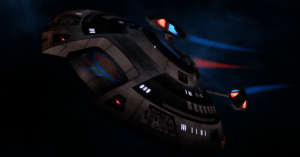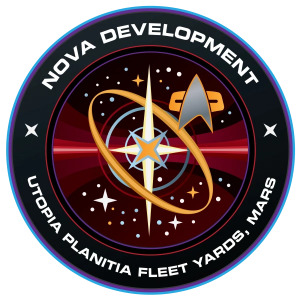USS Aurora
From Star Trek: Theurgy Wiki

| |
| Vessel Name: | USS Aurora |
| Registry: | NCC-72321 |
| Starship Class: | Nova-class |
| Starship Type: | Light Research Cruiser |
| Status: | Active |
| Purpose: | Short-term research missions |
| Constructed: | Utopia Planitia Fleet Yards |
| Commissioned: | September 20th, 2370 |
| Dedication: | Everything is theoretically impossible, until it is done.”
-Robert A. Heinlein |
| Dimensions: |
|
| Mass: | 110,000 metric tons |
| Decks: | 8 |
| Standard Crew Complement |
|
| Cruising Speed | Warp Factor 6.0 |
| Flank Speed | Warp Factor 7.0 |
| Burst Speed | Warp Factor 8.0 (Sustainable for 1 hour) |
| Armaments: |
|
| Defences: |
|
| Auxiliary Craft |
|
The USS Aurora (NCC-72321) was a Federation Nova-class starship assigned to Starbase 39-Sierra in the Alpha Centauri Sector Block. Designated as a Light Research Cruiser, the ship and her crew were responsible for short-term scientific assignments and planetary surveying in the Alpha Centauri Sector Block, mainly along the Romulan Neutral Zone. In 2381, during Theurgy's war against the parasites, she was commanded by Captain Rebecca Anders.
History
Construction, Launch and Commissioning
As one of the first ships of the Nova-class, closely following the prototype USS Nova (NX-72230) herself, the ‘keel’ of the USS Aurora was laid down at the Utopia Planitia Fleet Yards on February 5th, 2368 alongside those of her sister ships; the USS Anticipation (NCC-72319) and the USS Asimov (NCC-72320). Only two months into the assembly of the primary hull however, a problem presented itself with one of the pre-fabricated modules of the three sister ships. During the construction process of the USS Nova these modules had been built by hand but, for the mass production of the Nova-class ships, the design was copied into pre-fabricated modules that could easily be joined together in the orbital shipyards. One of these modules came with a very miniscule miscalculation that misaligned the secondary deflector on Deck 3 with the primary deflector on Deck 6 by a fraction of an inch. If left unaddressed, this misalignment had the potential to result in a resonance that could negatively impact the performance of the advanced sensor systems which flanked the secondary deflector on both sides. This forced Utopia Planitia to recalculate the design of the entire module and, as they subsequently fabricated entirely new ones, the construction of the three sister ships incurred a delay of several months.
The next significant delay would present itself just two years later, in mid-2370, when the USS Aurora was just mere months away from completion. At this point in time, Utopia Planitia was preparing the three sister ships for launch and had already scheduled extensive test flights, but the disappearance of the USS Equinox (NCC-72381) during a routine scientific survey near the Badlands put a sudden and unexpected stop to this. The disappearance of the USS Equinox, coupled with the fact that the Nova-class was a new class, led to concern over the design and Starfleet’s Advanced Starship Design Bureau ordered further construction to be halted following a detailed analysis of the USS Nova and all other Nova-class ships. It was only after the analysis revealed no discernible design flaws when Utopia Planitia was allowed to resume construction of the three Nova-class ships, but by then the project had once again suffered a delay of several weeks.
Physical Arrangement
Appropriate for her mission profile, the USS Aurora was essentially a flying sensor platform. Her design consisted of a saucer section with a curved triangular shape, which featured a secondary deflector and advanced sensor systems. These sensor systems were the most finely tuned and generally considered to be unparalleled in their application on Starfleet vessels at the time. Additionally, the secondary deflector was tied directly into the already oversized sensor systems, which allowed for much further scanning ranges. The secondary hull was directly attached to the underside of the saucer and housed the primary deflector dish, as well as the pylons of the two warp nacelles.
The small size of the USS Aurora made her one of the few vessels which were able to tolerate not only atmospheric flight, but also planetary landings. This made her uniquely suited for her role as a planetary survey ship, because the USS Aurora would frequently land and act as a field base for her various scientific survey teams.
Tactical Systems
While the USS Aurora was considered a Light Research Cruiser, she had a wide assortment of weaponry which allowed her to handle many threats on her own. Due to the original incarnation of the Nova-class as a torpedo gunship, the Aurora was equipped with eleven strategically placed phaser arrays; eight on the saucer and three on the secondary hull, two forward-facing photon torpedo launchers at the bow of the saucer opposite of the secondary deflector, and one aft-facing launcher.
Deck Layout
Crew
Commanding Officers
- Captain Rebecca Anders, Human
Command Crew
- Executive Officer
- Commander Took, Caitian
- Chief Tactical Officer / Chief of Security
- Lieutenant Amilee Monroe, Human
- Chief CONN Officer
- Ensign Lucy Hunt, Human
- Chief Engineering Officer
- Lieutenant Junior Grade Jesra Ries, Trill
- Chief Operations Officer
- Lieutenant Junior Grade Hailey Bennion, Human
- Chief Medical Officer
- Lieutenant Dr. James Owen, MD, Human
- Chief Science Officer
- Lieutenant Dr. Amber Beale, PhD, Human
- Chief Counselor
- Lieutenant Junior Grade Dr. Amanda Ashby, MD, Human (2379 - 2381)
- Lieutenant Junior Grade Arasina Gadiras, Bolian (2381 - Present)

